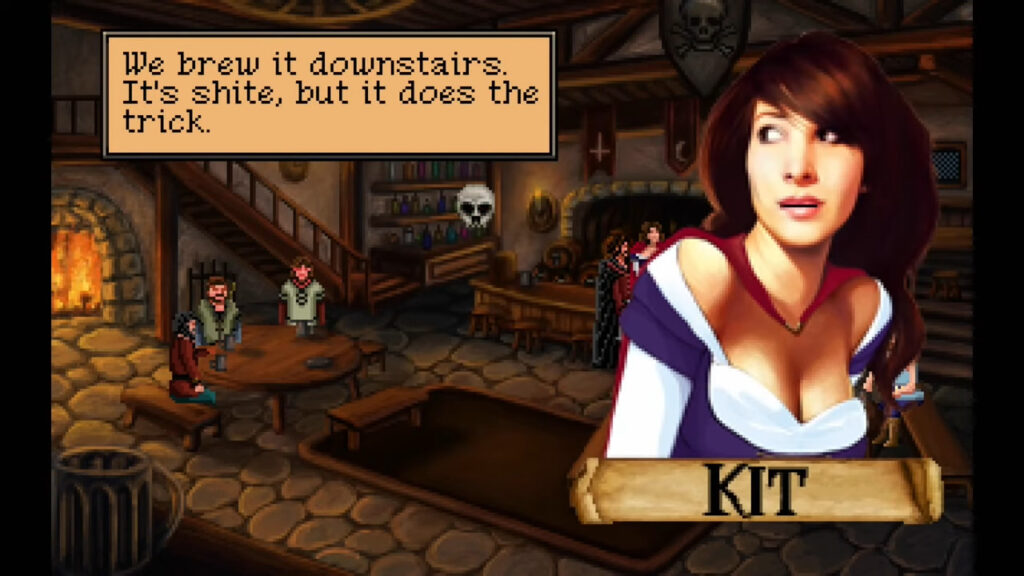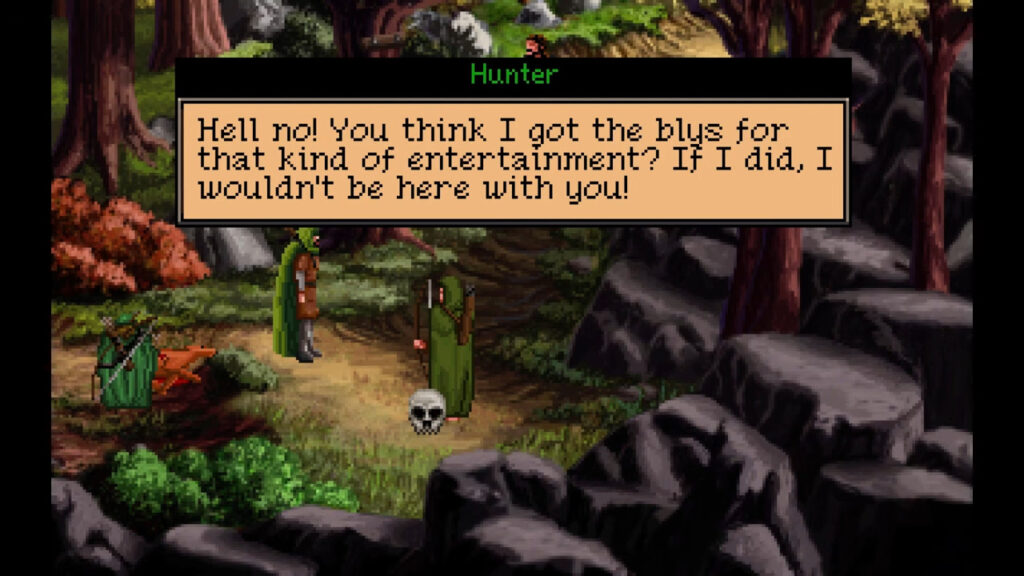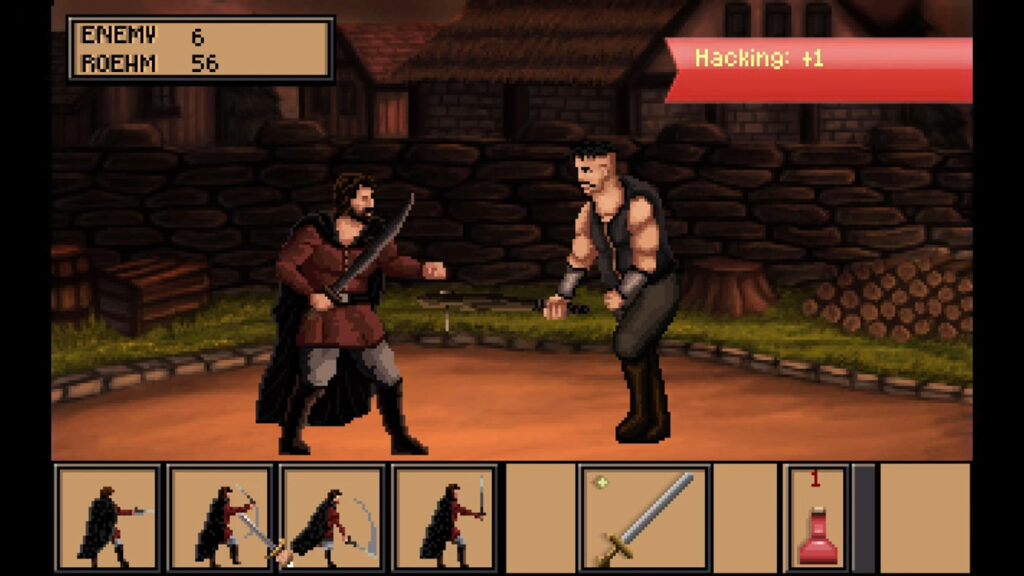
Developer: Infamous Quests
Publisher: Ratalaika Games
Platform: Switch, PS4, PS5, Xbox One, Xbox Series X|S, PC
Tested on: Switch
Quest for Infamy – Review
Quest for Infamy is a blast from the past in more ways than one. The game debuted way back in 2014, which is ages in video game time, but it also takes direct inspiration from games that are a lot older, specifically the old school point-and-click fantasy adventures from the late 80s and early 90s. Is this old school adventure going to be infamous or is it better off forgotten as soon as possible?
Story
If you’ve ever played a point-and-click adventure title that was developed by Sierra, then you should feel instantly familiar, as Quest of Infamy was directly inspired by these old-school games from the 80s and 90s. The game is pretty much a parody of the Kings Quest games. Players take on the role of a man named William Roehm. He finds himself running from his past and gets stuck in a backwater town named Volksville. As he has nothing better to do, he decides to hone his skills as an adventurer. With several mentors to choose from, William can then become infamous -hence the title- as either a sorcerer, a rogue, or a brigand. What follows is a series of silly, nonsensical events that can barely be considered as an actual story. You simply move from scene to scene as William aims to become infamous rather than famous. While these scenes certainly work as little vignettes, the entirety of Quest for Infamy feels more like a series of loosely interconnected absurdist sketches than anything else. The overall writing felt pretty juvenile to us, relying on cheap jokes rather than clever ideas. For example, pretty much every interaction William has with a woman is reduced to him poorly attempting to flirt, like he’s challenging Leisure Suit Larry instead of acting like an infamous adventurer.
Graphics
The majority of Quest for Infamy’s visuals looks like a carbon copy of the old school games it takes inspiration from, which makes sense of course. Juxtaposed against the gorgeous old-school pixel art are the character portraits, which are a lot more detailed. Of note here is the emphasis that the game puts on the depiction of its female characters, as each one of them is eager to put their cleavage on show, to the point that it becomes distracting -and not in a good way. The example below is actually one of the game’s more modest depictions of female cleavage. It’s a shame that Quest for Infamy has to rely on the old adagio of ‘sex sells’ in order to draw attention to itself, as the game would have been better if the over-the-top sexuality of the female NPCs was severely dialed down.
Sound
While we typically laud a game for providing us with voice acting, we have to say that Quest for Infamy offers some of the outright worst voice performances we’ve ever heard in a game. This doesn’t just extend to the performances themselves -although William himself is somewhat bearable- but to the audio quality as well. Certain characters sound like they recorded their lines in their bathroom. We can’t even blame the poor audio quality on the pandemic this time, like what happened with Triangle Strategy, as the audio was originally recorded in 2014. Add to this that the music feels generic and is hardly memorable and you’ve got a very disappointing soundscape.
Gameplay
For a game that is essentially a point-and-click adventure, filled with obtuse puzzles, there is a surprising amount of replayability as well as player freedom to be found within Quest for Infamy. Your ultimate goal is of course to build up a certain degree of notoriety within your chosen profession. You can choose either the path of the sorcerer, which allows you to focus on magic and mysticism, the path of the brigand, which is all about brute-forcing your way through whatever the game throws at you, or the path of the rogue, which involves using stealth and subtlety to achieve your goals. Each of the three paths has a distinct playstyle and offers a different way of solving the game’s plethora of puzzles. The game itself offers classic point-and-click adventure gameplay, which sees you gather items and use them to overcome obstacles, help NPCs and solve puzzles. In this regard, Quest for Infamy doesn’t really bring anything new to the table, instead relying on drawing the player in with the promise of cheap laughs and attractive ladies.
Admittedly, a lot of thought has gone into making Quest for Infamy’s world feel alive. NPCs will respond to previous actions and seem to have knowledge of your prior exploits, which felt like a nice touch. It made us feel like we were actively making a difference in the world of Lonaria. Unlike most other point-and-click adventures, there is also a healthy amount of combat, especially if you’ve chosen the path of the brigand. This provided a nice deviation from the conventions of the genre and we quite enjoyed bashing in the heads of our enemies, something we didn’t really expect to see in a point-and-click game.
Apart from combat, the game adheres to the same design principles as the old point-and-click adventure games of three decades ago, which means that for the most part, there is no hand-holding and instead, you’ll have to figure everything out for yourself. Combined with having to think outside of the box, this means that even die-hard fans of the genre will have their work cut out for them if they want to play through the game without relying on an online guide. We would’ve enjoyed having an in-game hint system of sorts but as the solution to a game like this is typically just a Google search away, it’s not all that much of an issue overall. That said, what is an issue, at least for the Switch version, is how frustrating the controls are. It was clear that this game was designed with the PC in mind first and foremost, and navigating the menus is needlessly hard and frustrating. If you want to give Quest for Infamy a go, then steer clear from this shoddy port and pick it up on Steam instead.
Conclusion
Mixed bag doesn’t even begin to describe Quest for Infamy. While there are some good elements present here, including the inclusion of combat and the fact that you can play the game in three different ways, we felt like the bad definitely outweighed the good, especially in the Switch port, and we can’t imagine that the other ports will fare better. Frustrating controls, terrible audio and a story that felt poorly written make for a title that is easily skipped. Your mileage may vary on PC, simply because the game won’t be as bad to navigate through, but we doubt that improved mouse and keyboard controls are enough to redeem Quest for Infamy. Thankfully, the lovely pixel art and the retro atmosphere do make up for the game’s shortcomings. We imagine fans of the old Sierra titles in particular will find revisiting this oft-forgotten era of video games enjoyable, but it’s a tougher pill to swallow for those that don’t have nostalgia for games like this.
Quest for Infamy - Review,








No Comments